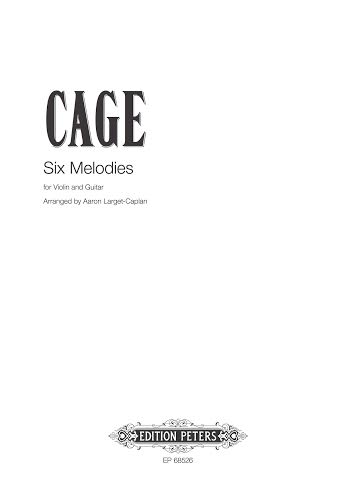John Cage, now in a handy guitar version
mainLife is full of surprises. Apparently ‘this is the first published work of Cage’s to feature the guitar’. Press release:

Boston – Celebrated composer John Cage’s official publisher, Edition Peters, issued Aaron Larget-Caplan’s arrangement of “Six Melodies” for violin and guitar in December, marking the first of Cage’s compositions to be officially published with guitar.
“Six Melodies” is an early work by John Cage, written in 1955, and originally for violin and keyboard. Aaron’s arrangement explores and expands on the timbre (color) qualities of the guitar in place of the keyboard and the guitar’s more intimate sound compliments the unique violin playing for a truly complimentary duo.
“Six Melodies” is quite approachable for audiences though their ability to transport listeners to other realms must be considered when programming”, Larget-Caplan said. “Music progressions and hierarchy of pitches take a backseat to an expansive exploration of timbre and rhythm.”

photo (c) Betty Freeman/Lebrecht Music&Arts





We wait with anticipation for the guitar version of 4’33”.
I hear it’s quite beautiful — although I prefer the version for trombone, marimba and electronic tape.
The problem with that version is, that the tape was made 15 years ago and is no longer compatible with modern equipment. On a recent performance on the Frankfurter Klangmesse, where an oldfashioned tape recorder was used, the tape ran off the reel and the trombonist and marimba player had to start all over again without the electonics, for which an apology was made to the audience.
The version for church organ was introduced by Philip Onslaught at the Five Choirs Festival in Awkwardsbury in 2005, where it was played between Vivaldi’s Gloria and Walton’s Belshazzar’s Feast during the rearrangement of the stage. Alas, nobody noticed.
It is best played by oneself at home, I found, and often I begin my morning composing session with playing it in its original version for piano solo.
Onslaught and Awkwardsbury…..nice one!
Here is the violin-guitar premiere performance with Sharan Leventhal & Aaron Larget-Caplan
https://www.youtube.com/watch?v=ItyE1mL7nOY
Oh Mr B – just when I was thinking of commenting with some positivity on your essay, you resort to cheap and obvious jokes. How disappointing.
These Melodies are exquisitely beautiful. A wonderful postscript to the string quartet. So fragile. I can well imagine that they will work for the guitar also.
The irony with Cage is that the more he introduced chance elements so as to remove the composer’s ego, the more the music still sounds like Cage and nobody else.
Well, this piece – as far as one could call it such – is nice. The early prepared piano pieces, which sound as a gamelan, are also nice. The later chance things are nice trials for sonic art, experiments for one time, but I have problems with the crazy hype piled upon Cage’s very modest achievements, to put it mildly. Cage was an amusing charlatan who plugged his ideas among the musical illiterati just at the time they got stuck with their self-fulfilling problems of serialism and/or aleatoricism.
Somewhere around 1980, Cage was given 8 hours of broadcasting time on the national classical station in the Netherlands, a whole day which he filled with his sonic games, among which plucking the needles of a hughe cactus on which contact microphones were glued, and rocking a nautilus shell filled with water to and fro in front of a microphone, which produced the sloshing sounds of a drowning horse. At that moment, a student of mine had put on the radio (as he told me later-on), hoping for some classical music, and was puzzled at the defect of only one station and with all the other stations intact.
There is nothing against what Cage did, but the context in which his work was put and the silly treament by academia, all that is absurd and has greatly contributed to the absurdism and incompetence proclaimed as ‘contemporary music’.
Sorry to have dissappointed you, but Cage could not possibly be treated seriously.
Can someone find one melody let alone six. Come back Stephane Grappelli, your genius is sorely missed.
The piece consists of small, disconnected fragments, as to reflect the composer’s idea of melody. First, a very long melodic line was written on a long stripe of paper, which was then cut into short pieces with a pair of scissors. The fragments were mixed in a box through intensive shaking, and then the fragments were glued on A4 sheets randomly, thereby giving them an objective quality (i.e. not interfered with by any melodic sense as a result from suppressing, authoritatian notions of craftmanship).
Thats quite an intellectual analysis of bullshit!
I have no idea how this piece was made, but this was how I could infer it.
Here is the premiere performance by Aaron Larget-Caplan
https://www.youtube.com/watch?v=ItyE1mL7nOY
Six Melodies by John Cage, arranged by Aaron Larget-Caplan
Sharan Leventhal, violin
Aaron Larget-Caplan, guitar
http://www.AaronLC.com